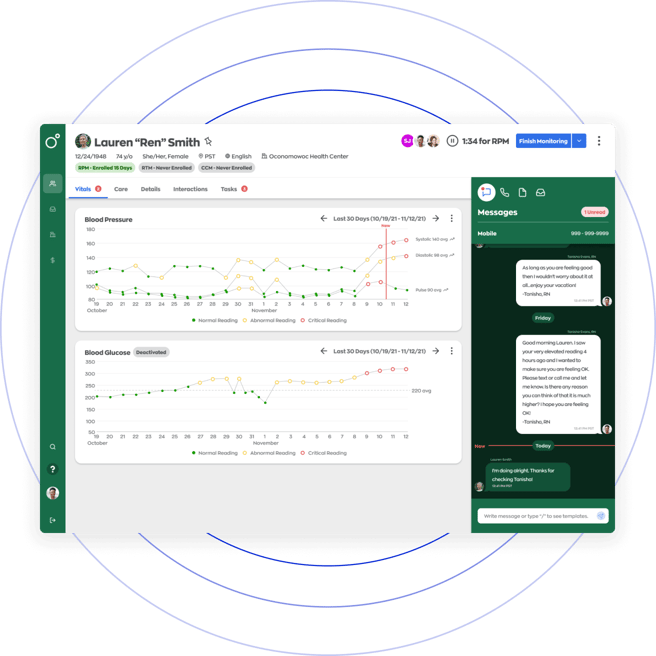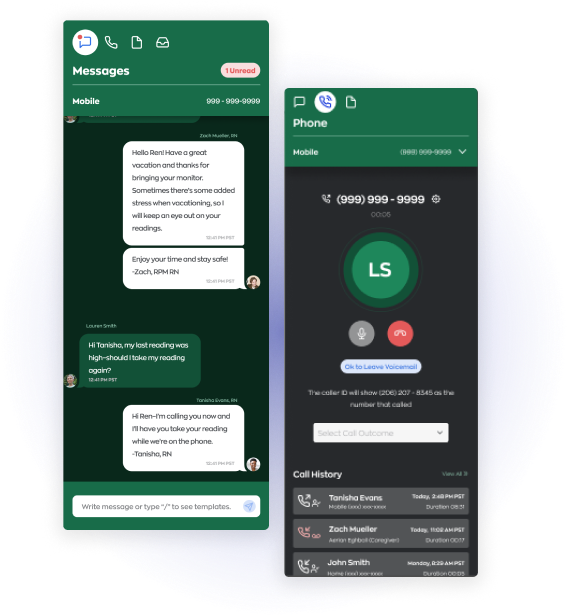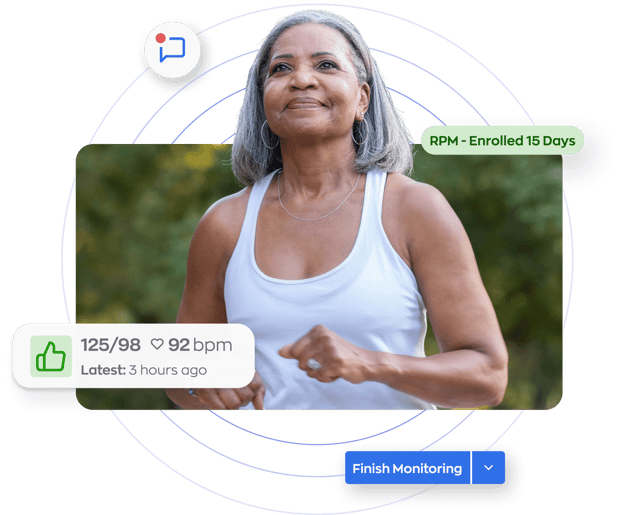“I have seen increased patient engagement since using Optimize Health’s remote care platform. The ability to easily reach out to patients and their friends and family is incredibly helpful.”
Dr. Aamir Iqbal, M.D., AFP Health
Improved Outcomes, Happier Patients
Optimize Health's remote patient monitoring platform is a simple-to-use system for healthcare providers like yours to provide improved, more modern healthcare. Maximize your time, increase patient engagement, and simplify your ability to monitor and deliver effective treatment plans for a huge range of patients.

Top-Notch Patient Care Every Day
Optimize Health delivers everything you need to provide the best patient care from one source, to or from any location. Patient health data is sent directly to our secure remote care monitoring platform where you can monitor and analyze it without the need for patient practice visits. Clinical workflows guide you to the best action, every time.


Seamlessly Track Individual Patient Progress
Centralized call history, patient notes and contact preferences supported by global search functionality, enhanced calling features, real-time notifications and message templates make delivering the best patient care a walk in the park.

Total Revenue and Program Potential in One View
Billing Dashboard displays patient billability and expected revenue so you're not left guessing.
+ Measure program health against total revenue potential
+ Revenue calculated based on total patients enrolled and billing eligibility
+ View patient adherence by CPT code
Remote Healthcare
Healthcare companies have developed healthcare software that provides remote health solutions using digital tools such as monitoring devices. These solutions allow medical service providers to track and test patients outside traditional healthcare settings, leading to better health services and improved patient outcomes.
At its core, remote healthcare involves monitoring tools and software platforms. Patient monitoring devices can track vital health metrics like blood pressure, blood glucose, and weight and automatically send that information to caregivers. This continuous monitoring allows providers to spot real-time health changes and potential issues. *Remote care* software platforms then aggregate all this data to give medical professionals a single view of each patient's health status and progress.
With these insights, remote healthcare companies can proactively manage patient care plans. They can also easily coordinate care teams and communicate with patients and caregivers more effectively. As a result, providers can spend less time reacting to health crises and more time preventing issues and catching problems early. For patients, remote healthcare means convenience since they can receive routine check-ins, ask and answer questions, and adjust medication from the comfort of their own homes.
Remote patient monitoring is typically used for managing chronic conditions. However, the benefits of remote healthcare extend to post-hospital care, complex disease management, and general population health. RPM companies continuously improve monitoring devices and software platforms, and that means remote care will become an even more critical component of how healthcare is delivered in the future.
The opportunities for improving outcomes and patient experience through remote healthcare solutions are endless. Remote monitoring programs that use wearable devices, mobile apps, and telehealth tools have the power to uncover new insights. They can detect health changes that traditional in-office visits miss.
Innovative remote health companies are leading the way toward a future in which healthcare will undoubtedly include more virtual visits. It will also involve remote patient monitoring and software, which will enhance the capabilities of providers and care teams.
What Is Remote Healthcare?
Remote healthcare relies heavily on technology to provide remote health services to patients at home. With remote healthcare platforms, patients can access medical staff without visiting a doctor's office. In addition, patients can get essential healthcare services and monitor chronic conditions from their homes.
By using such technology, healthcare providers gain tools that give them a better picture of a patient's health between office visits. With this transformation of how patients access and receive medical care, medical staff can be more proactive in caring for patients and addressing issues before they become serious.
Some examples of remote healthcare services include:
- Telemedicine: Patients have virtual consultations with doctors and specialists via video or phone instead of in-person visits. This allows patients to get medical advice and assistance from a distance.
- Remote patient monitoring: Patients with chronic conditions can use devices and sensors at home that transmit health data. Vital signs, such as blood pressure, pulse, and breathing rates, along with blood sugar levels and weight, are transmitted remotely to healthcare providers. This allows providers to monitor patients' health between in-person checkups.
- ePrescriptions: Doctors send prescriptions electronically to pharmacies instead of providing a physical piece of paper, which streamlines the process for patients to get their medications.
- Online health assessments: Patients can complete health surveys and questionnaires online to assess their symptoms and overall health. This can help identify potential issues and direct them to the right provider or treatment options.
- Virtual therapists and counseling: Patients can connect with mental health providers through video calls and messaging apps to get emotional support and therapy from anywhere.
- Online appointment scheduling: Patients can schedule and manage their appointments through an online portal or app connected to their healthcare provider, eliminating the need to call during office hours.
Remote healthcare is more accessible and convenient for patients while helping providers improve the quality and effectiveness of their care. As technology progresses, it will continue to transform how patients interact with the entire healthcare system.
Remote Healthcare Monitoring
Remote healthcare monitoring refers to using technology to monitor patients from a distance outside medical facilities. With remote health monitoring devices and systems, patients can receive care and track their health from home.
It helps achieve improved health outcomes by enabling early detection of health changes, reducing hospital readmissions, improving medication adherence, and streamlining follow-up care. This is done through a remote health monitoring system that sends patient health data to clinicians and care teams in close to real-time.
Several remote healthcare monitoring systems and devices can monitor patients' conditions from afar. They include the following:
- Blood Pressure Monitors: These are cuff-based monitors that patients can use at home to measure and transmit their blood pressure readings to their doctors. Doctors can monitor for high or low blood pressure issues.
- Weight Scales: Smart weight scales can measure a patient's weight and body composition, then send that data wirelessly to their doctor or care team. This helps monitor for weight gain or loss issues.
- Glucose Monitors: Continuous glucose monitors use a small sensor inserted under the skin to constantly measure blood sugar levels in diabetic patients. They can transmit readings to an app for patients and doctors to monitor.
- ECG Monitors: Electrocardiogram devices can measure a patient's heart rhythm and electrical activity. The data is transmitted to doctors who can monitor for arrhythmias or other cardiac issues.
- Oxygen Saturation Monitors: Pulse oximeters clip onto a patient's finger to measure blood oxygen levels. Chronic conditions like COPD require frequent monitoring, so wireless oximeters send readings to doctors to detect issues early.
- Activity Trackers: Fitness trackers and smartwatches can track patients' activity levels, steps, sleep, etc., and share that data with doctors to monitor mobility issues and functional decline.
- Cameras/Sensors: In-home sensors and camera systems allow remote patient monitoring, which is particularly helpful for older adults and people with cognitive issues. Motion sensors can detect if a patient has fallen, and cameras can allow medical professionals to visually check in on high-risk patients.
All these remote health monitoring devices work like an early warning system. They alert clinicians about an anomaly before a small problem becomes a significant health issue.
Remote Patient Monitoring
Remote patient monitoring (RPM) is an essential facet of remote healthcare services that helps providers give better care to patients. RPM leverages medical devices, sensors, and software to remotely monitor patients.
The RPM devices include wearables that track activity and monitor vital signs, glucose monitors, and scales. The collected data is sent through wireless networks for storage and triage in RPM services software that medical teams can access.
Providers then have real-time visibility into their patient's health status, vitals, and symptoms directly from the RPM software. It enables them to intervene proactively if health markers deteriorate between scheduled visits.
The benefits of remote patient monitoring are numerous for both patients and providers. For patients, it avoids unnecessary trips to the doctor for routine checkups and data collection.
Providers see benefits like reduced hospitalizations and readmissions and earlier detection of health issues leading to lower-cost interventions.
RPM companies that supply the devices, platforms, and services to power this new kind of remote care delivery are seeing increasing demand. Their RPM services can enable providers to scale remote patient care cost-effectively, improving outcomes while spending fewer resources per patient.
Remote Health Companies
Health care is undergoing a digital transformation driven by the impact of technologies from remote health monitoring companies. Optimize Health is a leading company offering full-service solutions with RPM software. Lower costs and better patient outcomes are the results of these new remote health approaches. However, delivering on those promises can be complex. Providers seeking to expand remote care services require advanced digital tools and strategies to manage the programs effectively.
Remote health companies specializing in RPM can help providers optimize their remote health initiatives. Some solutions such companies like Optimize Health provide are:
Chronic Care Management
Chronic care management solutions include:
- Comprehensive care planning by setting goals, monitoring progress, and adjusting care plans for patients with multiple chronic conditions over time.
- Medication management through reviewing medications to identify any issues that could impact conditions.
- Care coordination between the patient's various healthcare providers and caregivers.
- Health education by providing information and tools to help patients better manage their conditions.
Remote Patient Monitoring
RPM services offer the following solutions:
- Device monitoring which enables patients to use devices at home to track health data that is sent securely to their care teams.
- Virtual visits through regularly scheduled phone or video visits to discuss symptoms, medications, and questions.
- 24/7 access for patients to call or message their care team any time with questions or to report new symptoms.
- Alert notifications when a patient's readings fall outside normal ranges so care teams can follow up immediately.
With the right partner, providers can:
- Improve patient access and satisfaction
- Encourage proactive care and lower costs
- Achieve better health outcomes at lower risk
- Optimize staff efficiency and productivity




